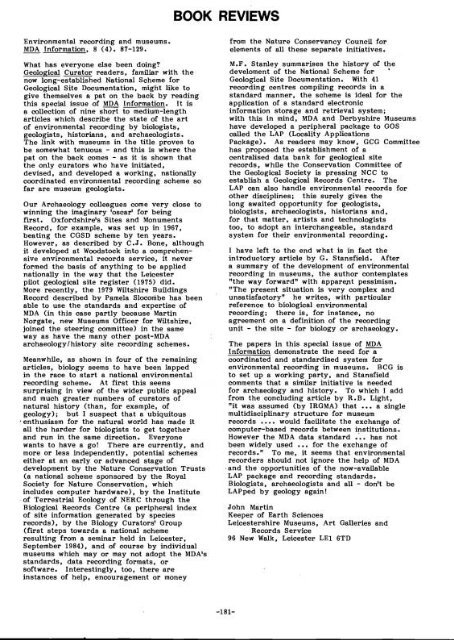Number 3 - Geological Curators Group
Number 3 - Geological Curators Group
Number 3 - Geological Curators Group
Create successful ePaper yourself
Turn your PDF publications into a flip-book with our unique Google optimized e-Paper software.
BOOK REVIEWS Environmental recording and museums. MDA Information, 8 (4). 87-129. What has everyone else been doing?<strong>Geological</strong> Curator readers, familiar with thenow long-established National Scheme for<strong>Geological</strong> Site Documentation, might like togive themselves a pat on the back by readingthis special issue of Information. It isa collection of nine short to medium-lengtharticles which describe the state of the artof environmental recording by biologists,geologists, historians, and archaeologists.The link with museums in the title proves tobe somewhat tenuous - and this is where thepat on the back comes - as it is shown thatthe onlv curators who have initiated.devised, and developed a working, nationallycoordinated environmental recording scheme sofar are museum geologists.Our Archaeology colleagues come very close towinning the imaginary 'oscar' for beingfirst. Oxfordshire's Sites and MonumentsRecord, for example, was set up in 1967,beating the CGSD scheme by ten years.However, as described by C.J. Bone, althoughit developed at Woodstock into a comprehensiveenvironmental records service, it neverformed the basis of anything to be appliednationally in the way that the Leicesterpilot geological site register (1975) did.More recently, the 1979 Wiltshire BuildingsRecord described by Pamela Slocombe has beenable to use the standards and expertise ofMDA (in this case partly because MartinNorgate, new Museums Officer for Wiltshire,joined the steering committee) in the sameway as have the many other post-MDAarchaeologylhistory site recording schemes.Meanwhile, as shown in four of the remaining articles, biology seems to have been lapped in the race to start a national environmental recording scheme. At first this seems surprising in view of the wider public appeal and much greater numbers of curators of natural history (than, for example, of geology); but I suspect that a ubiquitous enthusiasm for the natural world has made itall the harder for biologists to get togetherand run in, the same direction. Everyonewants to have a go! There are currently, andmore or less independently, potential schemeseither at an early or advanced stage ofdevelopment by the Nature Conservation Trusts(a national scheme sponsored by the RoyalSociety for Nature Conservation, whichincludes computer hardware), by the Instituteof Terrestrial Ecology of NERC through theBiological Records Centre (a peripheral indexof site information generated by speciesrecords), by the Biology <strong>Curators</strong>' <strong>Group</strong>(first steps towards a national schemeresulting from a seminar held in Leicester,September 19841, and of course by individualmuseums which may or may not adopt the MDA'sstandards, data recording formats, orsoftware. Interestingly, too, there areinstances of help, encouragement or moneyfrom the Nature Conservancy Council for elements of all these separate initiatives. M.F. Stanley summarises the history of thedeveloment of the National Scheme for '<strong>Geological</strong> Site Documentation. With 41recording centres compiling records in astandard manner, the scheme is ideal for theapplication of a standard electronicinformation storage and retrieval system;with this in mind, MDA and Derbyshire Museumshave developed a peripheral package to GOScalled the LAP (Locality ApplicationsPackage). As readers may know, GCG Committeehas proposed the establishment of acentralised data bank for geological siterecords, while the Conservation Committee ofthe <strong>Geological</strong> Society is pressing NCC toestablish a <strong>Geological</strong> Records Centre. TheLAP can also handle environmental records forother disciplines; this surely gives thelong awaited opportunity for geologists,biologists, archaeologists, historians and,for that matter, artists and technolo~iststoo, to adopt an interchangeable, stkdardsystem for their environmental recording.I have left to the end what is in fact the introductory article by G. Stansfield. After a summary of the development of environmental recording in museums, the author contemplates "the way forward'' with apparent pessimism. "The present situation is very complex and unsatisfactory'' he writes, with particular reference to biological environmental recording; there is, for instance, no agreement on a definition of the recording unit - the site - for biology or archaeology. The papers in this special issue of Information demonstrate the need for a coordinated and standardised system for environmental recording in museums. BCG is to set up a working party, and Stansfield comments that a similar initiative is needed for archaeology and history.To which I add from the concluding article by R.B. Light, "it was assumed (by IRGMA) that ... a single multidisciplinary structure for museum records .. . . would facilitate the exchange of computer-based records between institutions. However the MDA data standard .. . has not been widely used ... for the exchange of records." To me, it seems that environmental recorders should not ignore the help of MDA ,and the opportunities of the now-availableLAP package and recording standards.Biologists, archaeologists and all - don't beLAPped by geology again!John Martin Keeper of Earth Sciences Leicestershire Museums, Art Galleries and Records Service 96 New Walk, Leicester LE1 6TD
















